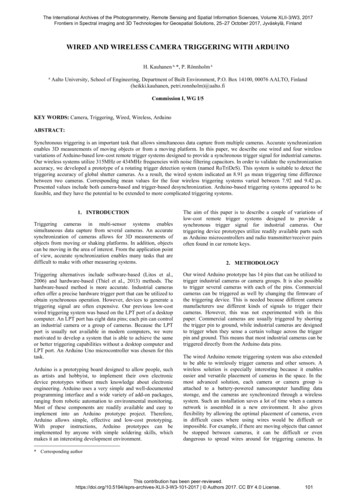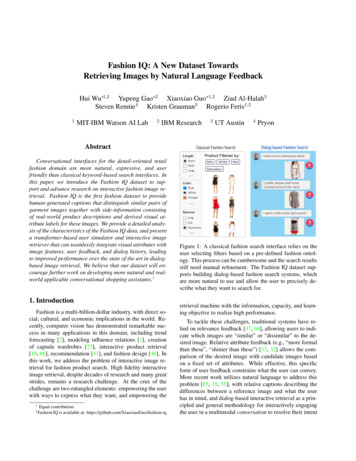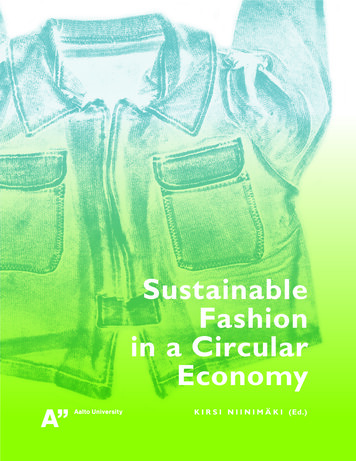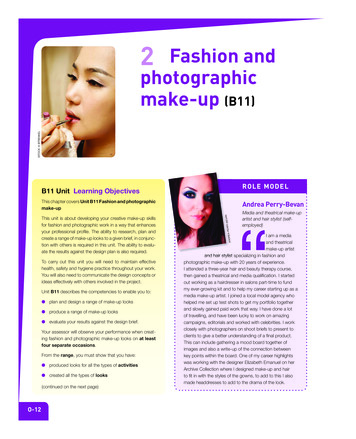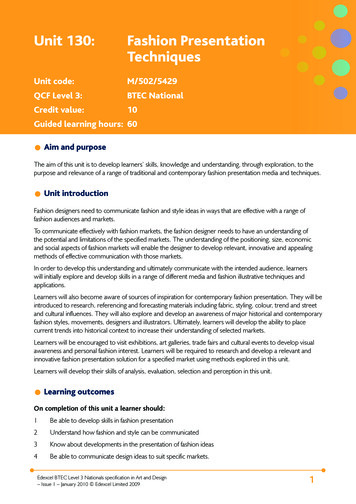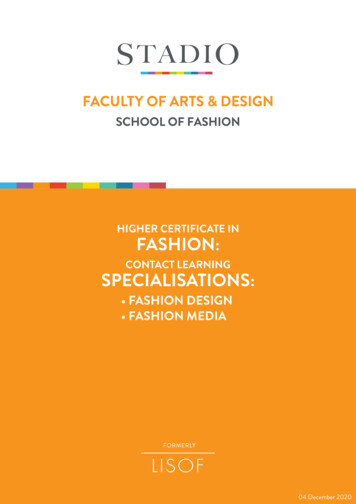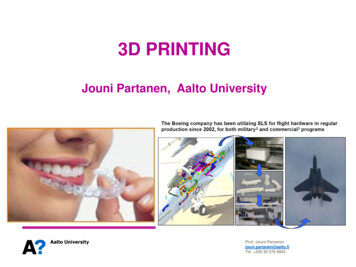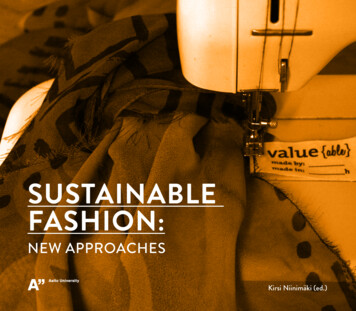
Transcription
sustainablefashion:New approachesKirsi Niinimäki (ed.)
Aalto University publication seriesArt Design Architecture 9/2013Aalto ARTS BooksHelsinki, Finlandbooks.aalto.fiISBN 978-952-5572-5ISBN 978-952-60-5573-2 (pdf)ISSN-L 1799-4853ISSN 1799-4853ISSN 1799-4861 (pdf)This book is produced in cooperation between Aalto University’s Schoolof Arts, Design and Architecture and the Baltic Fashion partnership. Thepublication is produced with the assistance of the European Union. Itscontent is the sole responsibility of the authors and can in no way be takento reflect the views of the European Union. The authors and Aalto UniversityGraphic design: Anja-Lisa HirscherPaper: Munken Lynx 120 gTypeface: Brandon grotesquePrinted in UnigrafiaHelsinki, Finland 2013
sustainablefashion:New approachesKirsi Niinimäki (ed.)
Table of contentSUSTAINABLE FASHIONKirsi NiinimäkiTenents of Sustainable Fashion 12ETHICS AND AESTHETICSKirsi NiinimäkiValues and Green Aesthetics 32Maarit AakkoWhat is the Role of Aesthetics in Sustainability?38Kirsi NiinimäkiEthical Design 44Maarit AakkoArtisanal and Slow : The Case of Anna Ruohonen56Maarit Aakko & Kirsi NiinimäkiExperimenting with Zero-Waste Fashion 68CRITICAL AND SOCIAL DESIGNKirsi NiinimäkiDesign Activism: Critical and Social 82Anu CorinGetting Critical“Why should I create anything?”86Kati Reijonen & Mari KrappalaChanging the World with Fashion 924Table o f c o ntent
PRODUCT SERVICE SYSTEMCosette ArmstrongProduct-Service Systems Design Thinking for Sustainable Fashion102Essi KarellPlanned Continuity – Multi-life Garments throughModular Structures & Supplemental Services110INNOVATION FOR GREEN BUSINESSKirsi NiinimäkiNew Values – New Business Opportunities126Anika KozlowskiSustainability Driven Innovation and Fashion Design134Lisbeth Svengren HolmInnovative Fashion Concepts and the Communication of Sustainability146COLLABORATIONKirsi NiinimäkiOpen Collaboration 160Dilys WilliamsThe Making of a Social Object: Collaboration betweenNike and Centre for Sustainable Fashion164Anja-Lisa Hirscher & Alastair Fuad-LukeOpen Participatory Designing for an Alternative Fashion Economy174AT THE END: ENVISIONING THE FUTUREKirsi Niinimäki 198WRITERS200Table o f c o ntent5
forewordThe idea for this publication emerged while organising the international seminar and exhibition“Sustainable and Innovative Fashion” in AaltoUniversity, Finland, on 2–3 October, 2013. Theevent was part of the Baltic Fashion project,where Aalto University focused strongly on producing new knowledge on the sustainable fashion field. The book sets out some of the themespresented in the seminar and exhibition. Additionally it focuses on new sustainable design andbusiness thinking while opening views on experimental design and green business approachesthrough real-life cases.This publication is intended to be used asa source of inspiration for designers and companies, and all stakeholders whose interest liesin the area of sustainable fashion. While thestrategies for sustainability are complex andapproaches are many, this publication presentsonly a few ways to approach sustainable fashion.I hope the publication offers inspiration on howto make positive change in current practices andhow to effect new mindsets, creating transformative fashion.Theoretical texts and the individual designcases and real-life business examples presentedin this book show that a change in mindset ispossible. They illustrate how we can challengeour traditional thinking and make manifest newways to frame the problem and seek creative solutions. Moreover when problem areas are seenas opportunities where design thinking can helpcreate successful outcomes, the chapters offerexamples of how to do fashion and business differently. Even the wildest design experimentations are beneficial and meaningful if they opennew kinds of thinking or even question the current fashion system.This book presents sustainable fashion asan approach that encompasses future-orientedvalue, as transformative and re-directive designenvisioning the future, as design and businessstrategy, as change agent experimentation, andas reframing business thinking. The content is divided into six themes: the basics of sustainablefashion, ethics and aesthetics, critical and socialdesign, product-service systems, innovation forgreen business and collaboration.I wish to thank all writers, researchers, designers and companies who contributed to thispublication with their best knowledge, writing,visuals and photos, and brave experimentationsin the field of fashion.And before you start this literary journey Iwant to emphasise that sustainable fashion is acreative process where design, quality, value, collaboration and networks form the core, not fashionable appearance and cheap prices. Enjoy theexperimental journey!In Tuusula, FinlandDecember 2013Kirsi Niinimäkif o rew o rd7
AbbreviationsBSR Baltic See RegionCEO Chief Executive OfficerCSF Centre for Sustainable FashionCSR Corporate Social ResponsibilityC2C Consumer to ConsumerDfE Design for EnvironmentDIT Do-it-TogetherDIY Do-it-YourselfDPC Designer-Producer-ConsumerEMAS Eco-Management and Audit SchmeEPR Extended Producer ResponsibilityLCA Life Cycle AnalysisMSI Material Sustainability IndexNGO Non-Governmental OrganizationPSS Product-Service SystemSAC Sustainable Apparel CoalitionSME Small and Medium-sized CompaniesZWF Zero Waste FashionZWPC Zero Waste Pattern Cutting8abbreviati o ns
The Baltic Fashion projectDespite dramatic changes within the last decaderesulting in a loss of a third of its volume and jobs,the fashion sector still plays a highly important rolethroughout the Baltic Sea Region (BSR): not onlythat it is characterised by a high number of smalland medium-sized enterprises (SMEs) and femaleemployees, but it is also an important source forcreativity and identity-building throughout theregion. Recent innovations and transnational cooperation as well as trends towards sustainable consumption offer important opportunities for Balticfashion designers and companies.Against this background, the Baltic Fashionproject partnership, composed of representatives from government, industry and education,explored possibilities for transnational cooperation in Baltic fashion support. As part of the BalticFashion project, they: analysed innovations within the industry,which are of relevance to Baltic fashion SMEsin view of offering them unique selling points,lowering production costs and/or expandingto new target groups,strengthened business cooperation in theBSR by compiling a comprehensive mappingof local production sites and organising BSRwide business cooperation events. Based oncurrent trends as well as strengths and weaknesses of each country, an analysis on possible scenarios for local production in the BSRcountries was developed,collected information on the current supportoffer for fashion businesses and conducteddirect surveys with fashion SMEs to enquireabout their needs. Based on the results, theydeveloped and tested fashion business supportmeasures as well as training,organised roundtables with national stakeholders to discuss actions to further supportthe Baltic fashion industry in the future, andexplored how cooperation within the Baltic Fashion project could be continued inthe future.All information, either collected or generated in theproject, was fed into the Baltic Fashion InformationPortal, the first-ever comprehensive web platformon Baltic fashion, accessible at www.balticfashion.eu.The Baltic Fashion project was supported bythe ERDF-financed Baltic Sea Region Programme2007–2013 under the priority “innovation”. Itwas implemented between December 2010 andDecember 2013.AcknowledgementsThis publication was made possible through thesupport and contributions provided by the BalticFashion partnership.f o rew o rd9
sustainablefashion
Contemporary aesthetic norms are based in capitalintensive, highly automated, unsustainable procedures. These procedures tend to reduce the potentialfor fulfilling employment and often ignore social andenvironmental losses. (Walker 2007, 76.)Walker, S. (2007). Sustainable by Design Explorations inTheory and Practice. London: Earthscan.
Tenents ofSustainablefashionKirsi Niinimäki
IntroductionTo unpack some of the complexity surroundingthe sustainability issues in the fashion field, thischapter briefly discusses some of the principlesbehind sustainable fashion. The chapter beginswith manufacturing and consumption, moves todesign principles, discusses the use phase andCSR (Corporate Social Responsibility) issues,and finally moves to new technologies.The environmental impact of garments can bedecreased during: fibre production, finishing, dyeing and printing processes global logistics during manufacturing andsales the use and the maintenance of the product disposal of the product.In all these phases there are myriad possibilities to lessen environmental impact. Recentlyethical and sustainability issues have entered thediscussion and have received a lot of attention,as fashion manufacturing has moved to lowercost and mainly Asian and Far East countriesduring the last 25 years.Current design and manufacturing systemsas well as economic models lead to unsustainablefashion consumption. The whole situation can beseen as a complex problem that needs creativeproblem solving, brave design thinking, questioning of current practices, and open collaboration between different industrial and marketingpartners.
The fashion industry andgarment consumptionTo understand the scale of the problem in thecurrent fashion system, the following paragraphswill give some key figures on the global textile andfashion industry. The textile and fashion industryis one of the biggest and oldest industrial sectorsin the world. It uses more water in its processesthan any other industry except agriculture, andit releases huge amounts of toxic chemicals intothe environment. The total volume of textile andfashion production at the global level is estimated to be more than 30 million tons annually,and therefore the environmental impacts of thisindustry are remarkable (Chen & Burns 2006).The textile and clothing industry has movedwith increasing speed and volume into low-costAsian and Far East countries during the last 25years. For example in Finland the watershed yearwas 1987, when textiles and clothing export figures were bigger than import rates for the lasttime; in the following year these figures reversed(Moilala 2013). Today it is estimated that in Finland, for example, about 95% of sold garmentsare imported; this figure is by and large the samein all Western countries (mostly between 9095%). And production has not only moved intolong logistic chains, but it also has grown and isstill growing. It is estimated that the global textile industry grew 25% between 2002 and 2010(Economy Watch 29.6.2010). Yet this tendency14sustainable Fashi o nstarted already in the 1980s: industry growthat the global level stood at 143% between theyears 1979–1990 and the Far East had the highest textile export growth of 430% during thatperiod (Lim 2003).On the consumption side rapid growth is alsoevident. For example in the UK the consumptionof fashion has increased by 37% between 2001and 2005 (the amount of clothes purchased percapita) (Allwood et al.2006). In Sweden theamount of clothes and home textiles releasedon the market rose by 40% between the years2000 and 2009 (Carlsson et al. 2011 in Tojo etal. 2012). In Finland the total volume of clothessold in 2010 was 70 212 tons (Tojo et al. 2012),which, for a population of 5 426 674, equalsan average of 13 kg of textiles per person. ThisWestern overconsumption causes environmental and social problems on the other side of theglobe, where the fibres are cultivated, fabrics arewoven, dyed and finished with chemicals, andsewn into garments in poor working conditions.Efficient mass manufacturing in lower costcountries has brought about low end-prices ofgarments. Cheap product prices lead consumers to impulse purchases and unsustainableconsumption behaviour: overconsumption, veryshort use time of products and premature disposal of the product (Niinimäki 2011). Growingconsumption also leads to increasing textile wastestreams. The American consumer disposes of 31kilograms of textiles and clothing each year, mostof which ends up in landfill (about 85%), and itis estimated that in the UK over 900 000 million items of clothing are disposed of each year(Brown 2010). Finnish consumers discard nearly17 kilograms of textiles and clothing a year, 75%of which ends up in landfill (Moisala 2013).Fashion markets are oversaturated and because of the extremely effective mass manufacturing system, the world is full of not only newfashion items and fashion shops but also unsoldclothing. Discount sales in fashion shops seem tobe a permanent phenomenon. In addition not allnew garments even enter the market; some go tolandfill directly from the factory, because of imperfect quality. Furthermore some garments arenever sold to consumers from the shop becausethere are too many offerings on the market,which is oversaturated. No one actually seemsto know the amounts of these unsold garments,which end up in landfill. It is estimated that theseunsold garments may account for even 5-10% ofthe whole fashion production. Fashion companies try to maintain their brands’ reputations inthis risky business and would rather destroy theunsold garments than discount them and releasethem onto the market in too big quantities.
Some fashion companies are trying to builda positive reputation by working together withdesigners in a new way with these unsold garments. In some cases young designers are invitedto create unique fashion collections made of unsold clothing. These redesigned collections are presented at social events with the help of the media.One example of this phenomenon was the secondReUse Republic event in Helsinki (8–9 April 2011),where thirteen young designers sold their uniquefashion made from fashion brand donations, preconsumer garments made into new apparel.ReUse Republic event in Kamppi shopping centre inHelsinki, Finland (Photo: Kirsi Niinimäki)S ustainable Fashi o n15
Sustainable designTextile and clothing consumption is estimated tocomprise about 5% of the environmental impactand carbon emissions of households. Even if thatfigure is relatively low, textile and clothing consumption is ever increasing (e.g. Spangenberg2001), and the more recent shortening of thelife spans of especially fast fashion items increases the environmental burden of the industry: allthose resources are wasted if the garments areworn for only a very short time or even not atall. Furthermore textile waste is growing problems in all Western countries and additionallythe chemical burden of textile manufacturing isa huge problem in Asian countries.In landfills most textiles do not decompose(polyester not at all while some natural materials do but often too slowly), and the problem isthat they are not planned to be suitable for composting. Fibres include many toxic chemicals,colours and finishings, and most garments aremade of blended materials unsuitable for composting. Composting is also problematic fromthe environmental viewpoint as it produces a lotof methane, which contributes to greater greenhouse gas emissions and global warming.Many consumers donate their old garmentsto charity shops, where some garments are resold to consumers and some are transported toother destinations like Africa. In Africa this inva-16sustainable Fashi o nsion of Western garments has largely destroyedlocal textile and garment production. In this wayWestern consumers have moved their consumption problems to the developing world and simultaneously helped to destroy the cultural value oflocal production and local textile traditions.In the 1970s, when environmental thinking started,the focus was more narrowly on solving waste problems caused by industrial production; currently sustainable thinking looks for ways to find sustainablebalance in the use of economic, social and environmental resources while simultaneously taking carenot to destroy the ability of future generations tofulfil their needs in a sustainable way. The notionof the triple bottom line means taking into consideration all three areas: people, planet and profit in asustainable manner. Additionally sustainable designand business strategies today include ethical andvalue-based thinking. While true sustainable thinking is rather wide and needs a holistic understandingand approach on many levels, it is more common tofocus on one narrower approach to eco-design andsustainability, for example focusing on the environmental impacts of manufacturing, substitutingmaterials with eco-materials, or focusing on ethicalissues in manufacturing (e.g. CSR, corporate socialresponsibility). This same kind of narrow thinking isalso seen in the use of eco-labels. Even though allthese aforementioned approaches are important,and it is positive that companies are interested ineco- and sustainable fashion, according to holisticthinking these strategies are limited and very oftendo not face the real problem areas. Such narrowapproaches alone therefore cannot solve the actualproblem, the overproduction and overconsumption
of clothing. The fashion discipline is far behind forexample industrial design in producing scientificenvironmental knowledge for designers’ use, tryingnew design methods to solve problems in more creative ways (Thomas 2008), or engaging consumers insustainable transformation processes. We need morecreative thinking in designing, manufacturing, consuming and doing business in the sustainable context.By definition eco-design and design for theenvironment (DfE) include environmental consideration and especially life cycle thinking. Thesustainable design approach adds to the aforementioned the ethical and social dimensions ofthe product, in its manufacturing, use and disposalphases (Tischner & Charter 2001, p. 120). Environmental consideration means that we use allrenewable resources in a manner where the usedoes not jeopardise the resources’ ability to renew:there has to be a balance. The use of non-renewable materials should be minimised, all materialsshould be recycled effectively, waste should beavoided, and any waste that is produced shouldbe treated appropriately without environmentalrisk. Social sustainability involves considering thewell-being of individuals, communities and societies at large. Finally, since the triple bottom lineapproach includes environmental, social and economic approaches to sustainability, financial feasibility is accordingly an important aspect (Elkington1994). This notion is also known as “People, Planet &Profit” (alternative prosperity) (Visser et al. 2008).The European Commission has defined principlesof environmental design as follows: Use low-impact materials whenever it ispossible: non-toxic, sustainably produced orrecycled materials which require little or nonatural resources (such as energy and water)to transport and process, and whose use doesnot threaten bio-diversityFocus on resource efficiency: create manufacturing processes, services and productsthat consume as few natural resources aspossibleInvest in high quality and durability: longerlasting and better functioning products,which age aesthetically and therefore reducethe impact of product replacementReuse, recycle and renew: design productsthat can be reused, recycled or composted(SEC 2009, p. 21).Sustainable fashion should include life cyclethinking, which takes into account all phases:design, manufacturing, logistics, retail, use and disposal. It is said that it is better to design life cyclesinstead of products; sustainable design includesconsideration of the use phase and end-of-lifethinking. At best the product has the possibility tohave several life cycles: it should be designed howthe product can be used after the first life cycleis over. From the environmental point of view itis best to use the product as it is, the second bestoption is to redesign a new product from it (e.g.through minor modifications), and the third optionis to recycle the materials.In the fashion field several guidelines and checklists have been created in recent years. Sandy Black(2011, pp. 46–47) gives the following guidelines fora sustainable fashion designer: design for the entiregarment’s life cycle (including use and disposal) reuse waste materialsrecycleupcyclerepair and remodel garmentsrecreate (e.g. existing design concepts)reduce (use of resources and creation ofwaste)use ecological materialsuse mono materialsuse new technologiescreate longer lasting productsdesign multifunctional clothesdesign for delight.S ustainable Fashi o n17
18Cradle-to-cradleRedesignRecyclingThe cradle-to-cradle principle was originallysuggested by Stahel in the 1970s (Lovins 2008,p.38) and again at the beginning of the new millennium by McDonough and Braungart (2002).According to this principle a product is designedand manufactured in such a manner that multiplelife cycles of the product or materials are possible. The cradle-to-cradle principle counsels thatafter the use phase the product will continue intechnical or biological life cycles, meaning it willbe recycled into a new material or it will be composted. This means that materials, dyes, chemicals and auxiliaries have to be suitable either forrecycling or composting (i.e. be biodegradable).This is a challenging task since, for instance, onlyfew textile colours or chemicals in the fibres canbe composted without environmental problems.The redesign of old materials into new fashion products has become popular at the beginning of the 21st century. Reuse and redesign issometimes called an eco-efficiency approach(Fletcher 2008) even though these strategiesdo not address the real problem: the increase inproduction and consumption. Reuse and redesignneed no changes in current consumer practices,so it is easy to accept. And since we have hugeamounts of textile and clothing waste, redesignhas begun to be a popular and trendy fashiondesign approach. In the redesign approach it isbeneficial to remember that all textile materials are not designed for clothing purposes, whichmight make them feel uncomfortable in use andeven unsuitable to wear against the skin.Recycling means that the product is recycled into newmaterial or fibres. Recycling can mean downcycling orupcycling. In downcycling processes we lose some of thevalue of the material and the quality is lower than in theoriginal material. Therefore downcycled material is mainlyused for filling purposes. Upcycling, in contrast, aimsto keep the product’s quality high and it can even meanincreasing the value of the material e.g. through design.The recycling approach needs mono materials,which means that the whole garment is made from onematerial only (including threads, buttons, zipper etc.).This makes it easy to recycle as one piece and one material (e.g. as with Patagonia’s products). Another possibility is that all parts are easy to disassemble and productshave to designed in this manner. But this is complicatedto realise in clothing where disassembling would be tootime-consuming and costly. Mono-materials in fashionitems are also not very common and nearly all garmentsare made of fibre blends that are complicated or impossible to recycle.If we accept the current consumption practices asthey are, and the concomitant huge amount of textile and clothing waste, we have to invest in a recyclingeconomy; then polyester is our choice. Polyester can bemelt-spun and this results in high quality material. Eventhough we see savings in e.g. energy, the process stillneeds a certain amount of virgin polyester material, andthis approach locks us into polyester production and theaccompanying oil production.sustainable Fashi o n
MaterialsWe do have more and more environmental information about textiles’ impacts during cultivation, manufacturing processes and the use phase.While a full compendium of this information isout of the scope of this publication, a short summary of materials’ environmental impact is givenbelow, as choosing materials for garments is oneof the most problematic phases in the sustainable fashion design process.Even though new materials are entering thefield of fashion, the most commercially important fibres used in the fashion industry are cotton and polyester, together accounting for over80% of all fibres, and the use of polyester hasgrown each year. Fibre consumption figures forthe year 2005 are shown in Table 1.Table 1. Fibre use (Simpson 2006)Fibres used worldwide in 2005 (million tons)NATURAL FIBRESCottonWoolSilk24.41.230.13Total 25.76MANUFACTURED tal2.532.633.9224.70Total 33.7859.54S ustainable Fashi o n19
Because diversity is an important value in sustainable development it is important to havevariety in textile fibres. Accordingly the currentpredominance of cotton and polyester can beseen as a problem from the viewpoint of diversity. More recently hemp, which is considereda more environmentally friendly alternative tocotton, has increased its share in sustainablefashion markets. Hemp grows fast, produceslong fibres and needs little pesticide. It even improves the soil structure and can be cultivated incolder climates. Environmental friendly enzymescan also be used in hemp processes. A similar fibreis flax (linen).It is not possible to say which fibres are moreenvironmentally friendly, natural fibres or manufactured fibres. Each fibre has its own environment burden. Production of acrylic, viscose andcotton into fibres needs a lot of water, and acrylic, polyester, viscose and cotton need a lot ofenergy in the production process. The land areaused to cultivate natural fibres might be betterused in food production, and some natural fibreshave a big environmental impact during cultivation, e.g. the water and pesticide use in cottoncultivation. In this regard organic cotton is a better choice; its cultivation uses fewer chemicals(pesticides and fertilisers).20sustainable Fashi o nMany synthetic fibres are by-products frompetroleum production and they are not renewable; on the other hand they can be recycledmore easily into good quality material (e.g. polyester) while cotton is mainly downcycled. Nonetheless high quality and recycled cotton has recently entered the market.New fibres are being developed and bio-basedplastics, for example, offer future potential alsoin the fashion field. These fibres can be producedfrom e.g. corn or soybean protein. Milk (casein)can also be used for fibre production. The bestsituation would be that all these new materialsare by-products from agriculture, should be biodegradable, and from renewable sources.The ecological viscose Tencel (lyocell) ismade from wood pulp and from trees specificallycultivated for this purpose. Tencel processinghas been developed to have low environmentalimpact and the material is biodegradable and renewable. (Chen & Burns 2006)Bamboo is a contradictory material: while itis marketed as an ecological choice (fast growing and renewable), in reality, its viscose processfrom fibre to yarn has a rather large environmental impact. However it is also possible to processbamboo fibre in a more environmentally friendlyway, not in a viscose process but as a normal fi-bre process. This environmentally better bamboofibre has been developed in Switzerland (Steffenat al. 2013).Some synthetic fibres have bigger environmental impact because they induce more sweating during use and need to be washed more oftenthan garments made of natural fibres. Recentresearch has pointed out new problem areas inthe use of, for example, polyester. Microplasticsfrom washing machine wastewater are pollutingbeaches and marine environments. These tinyparticles come loose when clothes made fromsynthetic fibres, like polyester, acrylic and polyamide, are being washed. (Browne et al. 2011.)Frequently laundered polyester sport clothingespecially causes this problem.The organisation Made By has categorisedtextile materials according to their environmental impact (see Table 2). Class A consists of fibres that have the lowest environmental impact(according to Made By).
Table 2. Textile materials’ environmental impact (Made by ASS ACLASS BCLASS CRecycled cottonRecycled nylonRecycled polyesterOrganic hempOrganic flax (linen)Tencel (Lenzing lyocellproduct)Organic cottonIn conversion cottonConventional hempRamiePLAConventional flax (linen)CLASS DCLASS EUNCLASSIFIEDVirgin polyesterPoly-acrylicLenzing Modal (viscoseproduct)Conventional cottonVirgin nylonRayonBamboo viscoseWoolGeneric viscoseSilkOrganic woolLeatherElasthanAcetateCashmere woolMohair woolFibre-based bamboo, etc.When choosing materials for garments, thematerial’s attributes and how they suit the particular wearing practices have to be consideredcarefully. It is also important to evaluate thematerial’s aging process so the material doesnot look old too fast. Studies have shown thatmaterials that are considered to age aestheticallyinclude high quality wool and leather (Niinimäki2010). In contrast materials like acrylic lookold after a rather short use time, as pilling willoccur. This is also seen with commonly used softfleece-type polyester.S ustainable Fashi o n21
The use phaseTextile maintenance uses much energy and water, inwashing, drying and ironing. We know that only 7.5%of laundry is actually heavily soiled. The majority iswashed more for cultural or behavioural reasons(Catton 2007). Garments frequently washed havethe highest environmental impact. By optimisingthe best textile materials, fit and colours for eachpurpose and use, the designer as well as the consumer can minim
Aalto ARTS Books Helsinki, Finland books.aalto.fi ISBN 978-952-5572-5 ISBN 978-952-60-5573-2 (pdf) ISSN-L 1799-4853 ISSN 1799-4853 ISSN 1799-4861 (pdf) This book is produced in cooperation between Aalto University’s School of Arts, Design and Architecture
